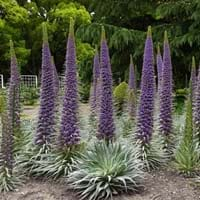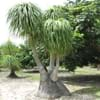Life Span
Biennial
Annual
Origin
Canary Islands
South America, Micronesia, New Zealand
Types
Not Available
Not Available
Habitat
tropical environments
coastal environs, Grassland, Roadsides, Waste areas, waterways
USDA Hardiness Zone
8-10
7-11
AHS Heat Zone
9 - 1
11 - 7
Sunset Zone
21,22
H1, 3a, 3b, 4, 5, 6, 7, 8, 9, 10, 11, 12, 13, 14, 15, 16, 17, 18, 19, 20, 21, 22, 23, 24
Habit
Upright/Erect
Clump-Forming
Flower Color
Light Blue, Blue Violet
Purple
Flower Color Modifier
Bicolor
Bicolor
Fruit Color
Non Fruiting Plant
Not Available
Leaf Color in Spring
Green, Gray Green
Green, Light Green, Dark Green
Leaf Color in Summer
Green, Gray Green
Light Green
Leaf Color in Fall
Green, Gray Green
Green, Light Green, Dark Green
Leaf Color in Winter
Light Green
Dark Green, Tan
Leaf Shape
Lobed
Grass like
Plant Season
Not Available
Spring, Summer, Fall, Winter
Sunlight
Full Sun
Full Sun
Type of Soil
Loam, Sand
Loam
The pH of Soil
Neutral, Alkaline
Acidic, Neutral
Soil Drainage
Well drained
Well drained
Bloom Time
Early Summer, Summer
Summer, Fall
Tolerances
Not Available
Drought, Salt
Where to Plant?
Ground
Ground
How to Plant?
Seedlings, Stem Cutting
Seedlings
Plant Maintenance
Medium
Medium
Watering Requirements
Medium
Average Water Needs
In Summer
Lots of watering
Lots of watering
In Spring
Moderate
Moderate
In Winter
Average Water
Average Water
Soil pH
Neutral, Alkaline
Acidic, Neutral
Soil Type
Loam, Sand
Loam
Soil Drainage Capacity
Well drained
Well drained
Sun Exposure
Full Sun
Full Sun
Pruning
Remove damaged leaves, Remove dead branches, Remove dead leaves
Remove damaged leaves, Remove dead branches, Remove dead leaves
Fertilizers
All-Purpose Liquid Fertilizer
All-Purpose Liquid Fertilizer
Pests and Diseases
Red blotch
Red blotch
Plant Tolerance
Drought
Drought
Flower Petal Number
Single
Single
Showy Fruit
Not Available
Yes
Foliage Texture
Fine
Fine
Foliage Sheen
Matte
Matte
Attracts
Not Available
Not Available
Allergy
Not Available
Itchiness
Aesthetic Uses
Showy Purposes
Showy Purposes
Beauty Benefits
Not Available
Not Available
Environmental Uses
Air purification
Air purification
Medicinal Uses
Not Available
Not Available
Part of Plant Used
Flowers, Leaves
Flowers, Leaves
Other Uses
Showy Purposes
Animal Feed, Used as Ornamental plant
Used As Indoor Plant
Sometimes
No
Used As Outdoor Plant
Yes
Yes
Garden Design
Container, Feature Plant, Mixed Border, Wildflower
Cutflower, Dried Flower/Everlasting, Feature Plant, Foundation, Groundcover, Mixed Border, Screening / Wind Break
Botanical Name
ECHIUM pininana
CORTADERIA jubata
Common Name
Giant Viper's Bugloss, Pine Echium, Tree Echium
Purple Pampas Grass
In Hindi
Tree Echium
Purple pampas grass
In German
Baum Aciam
Lila Pampasgras
In French
Arbre ACIAM
Pourpre herbe de pampa
In Spanish
árbol Aciam
hierba púrpura pampas
In Greek
δέντρο Aciam
Μωβ γρασίδι παμπάς
In Portuguese
árvore Aciam
grama roxa pampas
In Polish
drzewo Aciam
Purpurowy trawa pampasów
In Latin
lignum Aciam
Purpura Pampas herba
Phylum
Magnoliophyta
Magnoliophyta
Class
Magnoliopsida
Liliopsida
Family
Boraginaceae
Poaceae
Clade
Angiosperms, Asterids, Eudicots
Angiosperms, Commelinids, Monocots
Tribe
Not Available
Not Available
Subfamily
Not Available
Not Available
Number of Species
Not Available
Not Available
Properties of Tree Echium and Purple Pampas Grass
Wondering what are the properties of Tree Echium and Purple Pampas Grass? We provide you with everything About Tree Echium and Purple Pampas Grass. Tree Echium doesn't have thorns and Purple Pampas Grass doesn't have thorns. Also Tree Echium does not have fragrant flowers. Tree Echium has allergic reactions like Not Available and Purple Pampas Grass has allergic reactions like Not Available. Compare all the properties and characteristics of these two plants. Find out which of these plant can be used as indoor plant. If you are interested to decorate your house and garden, find out aesthetic uses, compare them and select the plant which will beautify your surrounding. Along with beautification, try comparing medicinal and edible uses of Tree Echium and Purple Pampas Grass and you can choose the plant having best and most benefits.
Season and Care of Tree Echium and Purple Pampas Grass
Season and care of Tree Echium and Purple Pampas Grass is important to know. While considering everything about Tree Echium and Purple Pampas Grass Care, growing season is an essential factor. Tree Echium season is Not Available and Purple Pampas Grass season is Not Available. The type of soil for Tree Echium is Loam, Sand and for Purple Pampas Grass is Loam while the PH of soil for Tree Echium is Neutral, Alkaline and for Purple Pampas Grass is Acidic, Neutral.
Tree Echium and Purple Pampas Grass Physical Information
Tree Echium and Purple Pampas Grass physical information is very important for comparison. Tree Echium height is 240.00 cm and width 30.00 cm whereas Purple Pampas Grass height is 90.00 cm and width 120.00 cm. The color specification of Tree Echium and Purple Pampas Grass are as follows:
Tree Echium flower color: Light Blue and Blue Violet
Tree Echium leaf color: Green and Gray Green
Purple Pampas Grass flower color: Purple
- Purple Pampas Grass leaf color: Green, Light Green and Dark Green
Care of Tree Echium and Purple Pampas Grass
Care of Tree Echium and Purple Pampas Grass include pruning, fertilizers, watering etc. Tree Echium pruning is done Remove damaged leaves, Remove dead branches and Remove dead leaves and Purple Pampas Grass pruning is done Remove damaged leaves, Remove dead branches and Remove dead leaves. In summer Tree Echium needs Lots of watering and in winter, it needs Average Water. Whereas, in summer Purple Pampas Grass needs Lots of watering and in winter, it needs Average Water.





